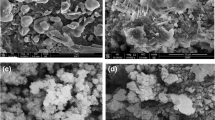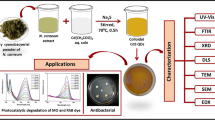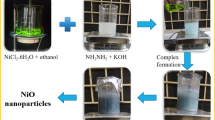Abstract
Finding the materials, which help to control the water pollution caused by organic and bacterial pollutants is one of the challenging tasks for the scientific community. We have developed and characterized a material, which can be used to remove of pollutant compound. ZnO quantum dots decorated CuO nanosheets composites have been synthesized using a hydrothermal method. The as synthesized ZnO QDs/CuO NSs composites were characterized by various techniques. The Crystallite sizes were to be obtained 12.5 and 3.2 nm for CuO NSs and ZnO QDs/CuO NSs composite. The energy band gap of the CuO NSs and ZnO QDs/CuO NSs composite are calculated to be 2.01 and 1.86 eV, respectively. The CuO NSs and ZnO QDs/CuO NSs composites are efficiently utilized for the photocatalytic degradation of Tetanus toxin (TeNT) as a target pollutant under UV and sunlight irradiation. The ZnO QDs/CuO NSs composites reveal excellent photocatalytic degradation of TeNT by degrading it up to 75% under UV and sunlight irradiation. The photocatalysis efficiency of ZnO QDs/CuO NSs composite is clearly higher than CuO NSs. The antibacterial activity of the CuO NSs and ZnO QDs/CuO NSs composites was also investigated on gram positive (Enterococcus faecalis) and gram negative (Micrococcus luteus) microbes.
Similar content being viewed by others
Avoid common mistakes on your manuscript.
1 Introduction
Water pollution is a severe problem in many countries. It is mainly caused by compositions of organic and bacterial pollutants, which result in potential threats for living organisms [1, 2]. Tetanus toxin is an extremely potent neurotoxin and it’s also called spasmogenic toxin, or TeNT. The LD50 of this toxin has been measured to be approximately 2.5–3 ng/kg, making it second only to Botulinum toxin (LD50 2 ng/kg) as the deadliest toxin in the world [3]. A variety of methods has been proposed for controlling the water pollutants, such as adsorption, oxidation, flocculation, coagulation, sedimentation, and membrane filtration [4]. Light-driven photocatalysts based on metal-oxide semiconductors may have the potential for controlling both, organic and bacterial pollutants in water. This is due to the fact that these materials are not only capable of utilizing UV and visible light to alleviate the organic pollutants present in water, but they also inhibit the bacterial growth, which is the most challenging task. Photocatalyst is a promising approach for removing water pollutants with high efficiency. In the presence of photocatalyst, the photo-induced strong oxidation and reduction activity with long-term stability can decompose the contaminants effectively and kill the microbes by producing active oxidizing agents [5, 6].
Due to the different properties such as low cost synthesis, non-toxicity, thermal stabilities, and electronic properties, p-type semiconducting metal oxide nanomaterials such as CuO [7] have attracted the attention of the research, recently [8]. Among the various p-type metal oxides, CuO, a black colored material with narrow band gap energy is most widely studied materials.
Quantum dots (QDs) with narrow size distribution and high luminescent efficiency have attracted attention of researchers due to several properties. Recently, ZnO QDs are being investigated in a much wider scope, from the materials aspects in terms of lattice structure, doping and surface modifications to optoelectronic aspects such as luminescent properties, binding energy and band gap studies [9,10,11].
The main focus of the present investigation is to determine the photocatalytic performance of the synthesized products in degrading TeNT in UV and sunlight and the antimicrobial activity for different microbes can also not be found.
2 Materials and methods
2.1 Materials
All the chemicals were obtained from Sigma-Aldrich Ltd, USA.
2.2 Preparation of CuO nanosheets
In a typical synthesis process, 0.01 M aqueous solution (50 mL) of copper nitrate was mixed with 0.01 M aqueous solution of hexamethylenetetramine (50 mL) under vigorous stirring. In order to maintain a pH 12 of the solution, KOH was added drop by drop with continuous stirring. After stirring, the suspension was transferred to Teflon-lines stainless steel autoclave and heated to 180 °C for 8 h. The product formed was filtered, washed with ethanol–water mixture solution and finally dried at 70 C for 4 h in oven.
2.3 Preparation of ZnO quantum dots decorated CuO nanosheets
200 mg Zinc acetate and 500 mg of the as-prepared CuO nanosheets was added into 50 mL distilled water. The reaction was carried out by dropwise addition of KOH solution to zinc acetate solution with constant stirring. The final pH of the solution was maintained at 10. The obtained suspension was transferred into a 100-mL Teflon-lined stainless-steel autoclave, and then was heated to 180 °C for 10 h. After natural cooling to room temperature, the product was collected and washed with ethanol–water mixture solution.
2.4 Characterization instruments
A transmission electron microscope (TEM) (Zeiss EM-900) was used to examine the particle size and morphology of ZnO QDs/CuO NSs composites and X-ray diffractometer (XRD) Philips X’Pert was measured for evaluation of crystalline information. X-ray photoelectron spectroscopy (Kratos Axis Ultra DLD) and UV–Vis spectroscopy studies (TEC Avaspec 2048) were performed for evaluation of optical information.
2.5 Photocatalytic activity
In order to evaluate the photocatalytic efficiency of the ZnO QDs/CuO NSs composites, photocatalytic measurements were done by degradation of TeNT in photocatalytic reaction under mercury lamp radiation with 100 W of UV power. For the measurement, a suspension of 10 mg of the as prepared photocatalyst powder and 100 mL of an aqueous solution of the TeNT having a concentration of 1 mg/L were mixed and stirred in a dark place for about 30 min to reach the adsorption desorption equilibrium condition between the photocatalyst and TeNT molecules. In order to initiate the photocatalysis, the obtained suspensions were exposed to sunlight. A second photoreactor for the solar photocatalysis experiments was constructed using a borosilicate glass container of 250 mL capacity, 100 mm internal diameter and 200 mm in height where sunlight was directed axially at the center of the reactor. The TeNT concentration was distinguished with the aid of a two dimensional Gas Chromatogharphy (GC∗GC) (Kimia Shangarf Pars Research CO., Iran).
2.6 Antibacterial activity
The antibacterial activity was investigated by studying the disinfection efficiency of the synthesized products for two bacterial strains, namely Enterococcus faecalis (gram positive) and Micrococcus luteus (gram negative) microorganisms. In this experiment, the bacteria E. faecalis and M. luteus were cultivated by using the agar-disc-diffusion method. In this method, a nutrient agar medium (28 g/L in DI water) and nutrient broth (13 g/L in DI water) were prepared. The nutrient agar medium was then poured into autoclaved Petri dishes. The active culture growth of each bacterial strain was spread on nutrient agar. Wells (10 mm) prepared in the agar plates were inoculated and 200 μL of sample (several concentration) were put in the wells to control the bacterial growth. The incubation was continued for 24 h at 37 °C, and after incubation, the zone of inhibition was analyzed to determine the antibacterial efficiency of the synthesized products.
3 Results and discussion
3.1 Characterization of the ZnO QDs/CuO NSs
3.1.1 XRD
The XRD analysis was performed to investigate the structure and crystal phase of the as synthesized samples. Figure 1 depicts the XRD pattern of CuO NSs and ZnO QDs/CuO NSs composite. In the XRD spectra of the CuO NSs, all the diffraction peaks are assigned according to the standard pattern of monoclinic phase (JCPDS No: 05-0661). The diffraction peaks of ZnO QDs/CuO NSs are assigned to wurtzite phase for ZnO QDs structure (JCPDS No: 36-1451). It can be seen that the intensity of the diffraction peaks of CuO NSs changes by the introduction of ZnO QDs in the ZnO QDs/CuO NSs composite. Besides the representative peaks of the monoclinic phase of CuO NSs in the XRD spectra of the ZnO QDs/CuO NSs composite, we could not observe several peaks correspond to wurtzite phase for ZnO QDs. The Crystallite sizes were distinguished from the Scherrer equation [12,13,14,15] to be obtained 12.5 and 3.2 nm for CuO NSs and ZnO QDs/CuO NSs composite.
3.1.2 TEM
The structural morphology, shape, and size of the as ZnO QDs/CuO NSs composite, and the distribution of ZnO QDs over the CuO NSs were analyzed by using TEM micrographs as shown in Fig. 2a. As can be seen, image confirms the sheet-like morphologies for the synthesized CuO nanosheets. Finally, Fig. 2a, which shows TEM images of the ZnO QDs/CuO NSs composite, demonstrate that the ZnO QDs are well decorated over the CuO layers. The average sizes of ZnO QDs/CuO NSs composite (Fig. 2b) were found as 2.25 nm.
3.1.3 X-ray photoelectron spectroscopy (XPS)
Quantitative spectroscopic method (X-ray photoelectron spectroscopy) was used to for determine the elemental analysis and the elements chemical-states of the materials. The XPS spectra of Cu 2p, Zn 2p, and O 1s are displayed in Fig. 3a. From Fig. 3b, the spin orbit peaks of the Zn 2p (3/2) and Zn 2p (1/2)binding energy appeared at around 1020.0 and 1041.1 eV. From Fig. 3c, Cu 2p (3/2) and Cu 2p (1/2) binding energy appeared at around 931.5 and 951.1 eV. Figure 3d indicated the O 1s spectrum at 528.0 eV is assigned to lattice oxygen (O2 −) for ZnO QDs/CuO NSs.
3.1.4 UV–Vis absorption spectroscopy
Figure 4 represents the UV–Vis absorption spectra of the as-synthesized CuO NSs and ZnO QDs/CuO NSs composite. These spectra are almost identical except for the slight variation in peak position and intensity of the absorbance band of the ZnO QDs/CuO NSs composite composite. The absorption band edge of ZnO QDs/CuO NSs composite is red-shifted compared to CuO NSs, which may be due to the restoration network of the π-π conjugation of ZnO QDs in the composite [16]. The energy band gap (Eg) can be determined by using the following relation [17, 18]:
where α, hν, and A are the coefficient of absorbance, the energy of the incident photons, and a constant, respectively. The energy band gap of the CuO NSs is calculated to be 2.01 eV whereas for the ZnO QDs/CuO NSs composite a value of 1.86 eV is determined.
3.2 Photocatalytic activity
The photocatalytic performance of the as-synthesized CuO NSs and ZnO QDs/CuO NSs composite is evaluated by investigating their catalytic efficiency for the degradation of TeNT under the sunlight and UV light. The photocatalysis efficiency of the ZnO QDs/CuO NSs composite was recorded as a function of irradiation time with a regular interval. The photodegradation percent is calculated by using the following relation [19,20,21,22,23,24]:
where Co and C are the concentrations of the TeNT before and after irradiation, respectively. Figure 5 shows the amount of the degradation increase with time as expected. However, this photocatalysis efficiency of ZnO QDs/CuO NSs composite is clearly higher than CuO NSs are used as photocatalyst. These results indicate that the chemical bond coupling between the CuO NSs and ZnO QDs increase the photocatalytic activity for photodegradation. The photocatalytic properties of the materials strongly depend on the active surface area available for the interaction with the TeNT molecules, which causes a delay in recombination of electrons and holes. The photogenerated electrons are transferred to the active surface of the catalyst and react with O2 present in the sample, which then is converted into O2−. The interaction of the photocatalyst with water produces OH radicals. The O2− superoxide and OH radicals act as strong oxidizing agents, which decomposing TeNT. In the process of photodegradation, the absorption of photons by the CuO NSs and ZnO QDs/CuO NSs composite when irradiated with UV light and sunlight results in holes in the valence band and a transfer of electrons into the energy states lying below the conduction band. The photo degradation of TeNT under sunlight is higher than UV light. The mechanism of the photocatalytic degradation of TeNT can be described by the following reactions:
According to the kinetics following the Langmuir–Hinshelwood mechanism, the pseudo rate constant k for the photocatalytic degradation reaction of the TeNT can be calculated by the following relation:
where t is the time of irradiation.
Table 1 presented the kinetics study for TeNT degradation at different light. The straight line ln(C0/Ct) was plotted against time confirming the assumed first-order kinetics (figure not shown).
3.3 Antibacterial activity
We have also studied the antibacterial activity of the CuO NSs and ZnO QDs/CuO NSs composite. The measurements were performed on E. faecalis (gram positive) and M. luteus (gram negative) bacterial strains as zone of inhibition tests. The sizes of the inhibition zones found were different depending on the type of bacteria. A larger inhibition zone indicates a greater effect on the microbes due to the interaction with the CuO NSs and ZnO QDs/CuO NSs composite, while a smaller inhibition zone points to a less efficient antibacterial activity. The antibacterial activity of the CuO NSs and ZnO QDs/CuO NSs composite are shown in Fig. 6. A possible explanation for the anti-microbial activity of the metal oxide nanostructures against the E. faecalis and M. luteus bacterial strains is an electrostatic interaction between the positive metal oxide nanostructures and the negative charges of the microbes [25], which prevent the further growth of the microbes. It could also be due to the fact that the semiconducting nanomaterials release ions. These ions react with the proteins present in the bacterial cells, which leads to death of the microbes [26, 27]. It was found that the MIC values for the antibacterial assay in the presence of nanomaterials and were around 0.25 mM with, and inhibition value of E. faecalis for CuO NSs and ZnO QDs/CuO NSs composite are 71.9 and 87.9% and inhibition value of M. luteus for CuO NSs and ZnO QDs/CuO NSs composite are 61.9 and 76.9%, respectively (Fig. 6).
4 Conclusions
We have performed a synthesis of CuO NSs and ZnO QDs/CuO NSs composite via a hydrothermal method. The synthesized samples were characterized by XRD, TEM, X-ray photoelectron and UV–Vis absorption spectroscopy. TEM measurements confirmed the ZnO QDs dispersed over CuO NSs. The decrease in the value of the optical band gap calculated using UV–Vis data of the ZnO QDs/CuO NSs composite compared to CuO NSs may be due to the interaction between CuO NSs and CuO NSs. The CuO NSs and ZnO QDs/CuO NSs composite are successfully applied for the photocatalytic degradation of TeNT under direct sunlight and UV light irradiation. In summary, the ZnO QDs/CuO NSs composite shows a considerable potential for an application as photocatalytic and antibacterial material.
Change history
29 March 2024
This article has been retracted. Please see the Retraction Notice for more detail: https://doi.org/10.1007/s10854-024-12451-5
References
H. Tong, S. Ouyang, Y. Bi, N. Umezawa, M. Oshikiri, J. Ye, Nano-photocatalytic materials: possibilities and challenges. Adv. Mater. 24, 229–251 (2012)
R. Abe, Recent progress on photocatalytic and photoelectrochemical water splitting under visible light irradiation, J. Photochem. Photobiol. C 11, 179–209 (2010)
Botulism, World Health Organization. Accessed 18 Jan 2017
A.K. Verma, R.R. Das, P. Bhunia, A review on chemical coagulation/flocculation technologies for removal of colour from textile waste waters. J. Environ. Manag. 93, 154–168 (2012)
M. Mehrjouei, S. Muller, D. Moller, A review on photocatalytic ozonation used for the treatment of water and waste water. Chem. Eng. J. 263, 209–219 (2015)
J. Xiao, Y. Xie, H. Cao, Organic pollutants removal in waste water by heterogeneous photocatalytic ozonation. Chemosphere 1, 1–17 (2015)
S. Steinhauer, E. Brunet, T. Maier, G.C. Mutinati, A. Köck, O. Freudenberg, C. Gspan, W. Grogger, A. Neuhold, R. Resel, Gas sensing properties of novel CuO nanowire devices. Sens. Actuat. B Chem. 187, 50–57 (2013)
A. Klinbumrung, T. Thongtem, S. Thongtem, Characterization and gas sensing properties of CuO synthesized by DC directly applying voltage. Appl. Surf. Sci. 313, 640–646 (2014)
J. Joo, S.G. Kwon, J.H. Yu, T. Hyeon, Adv. Mater. 17, 1873 (2005)
F. Qu, D.R. Santos, N.O. Dantas, A.F.G. Monte, P.C. Morais, Phys. E 23, 410 (2004)
K.-F. Lin, H.-M. Cheng, H.-C. Hsu, L.-J. Lin, W.-F. Hsieh, Chem. Phys. Lett. 409, 208 (2005)
A. Fakhri, S. Behrouz, Sol. Energy 117, 187–191 (2015)
A. Fakhri, S. Behrouz, Sol. Energy 112, 163–168 (2015)
M.E. Borges, M. Sierra, E. Cuevas, R.D. García, P. Esparza, Sol. Energy 135, 527–535 (2016)
G.B. Markad, S. Kapoor, S.K. Haram, P. Thakur. Sol. Energy 144, 127–133 (2017)
A. Fakhri, P.A. Nejad, M. Pourmand, J. Photochem. Photobiol. B 159, 211 (2016)
A. Fakhri, S. Behrouz, M. Pourmand, J. Photochem. Photobiol. B 149, 45 (2015)
A. Fakhri, R. Khakpour, J. Lumin. 160, 233–237 (2015)
A. Fakhri, M. Pourmand, R. Khakpour, S. Behrouz, J. Photochem. Photobiol. B 149, 78 (2015)
D. Lu, P. Fang, X. Liu, S. Zhai, C. Li, X. Zhao, J. Ding, R. Xiong, Appl. Catal. B 179, 558–573 (2015)
D. Lu, B. Zhao, P. Fang, S. Zhai, D. Li, Z. Chen, W. Wu, W. Chai, Y. Wu, N. Qi, Appl. Surf. Sci. 359, 435–448 (2015)
D. Lu, P. Fang, Y. Liu, Z. Liu, X. Liu, Y. Gao, F. Chen, F. Niu, J. Nanopart. Res. 16, 1–12 (2014)
D. Hazarika, N. Karak, Photocatalytic degradation of organic contaminantsunder solar light using carbon dot/titanium dioxide nanohybrid, obtainedthrough a facile approach. Appl. Surf. Sci. 376, 276–285 (2016)
A. Qu, H. Xie, X. Xu, Y. Zhang, S. Wen, Y. Cui, Appl. Surf. Sci. 375, 230–241 (2016)
V. Lakshmi Prasanna, R. Vijayaraghavan, Mater. Sci. Eng. C 77, 1027–1034 (2017)
Y. Hou, J. Feng, Y. Wang, L. Liangchao, J. Mater. Sci. 27, 6615–6622 (2016)
S. Ramya, G. Viruthagiri, R. Gobi, N. Shanmugam, N. Kannadasan, J. Mater. Sci. 27, 2701–2711 (2016)
Acknowledgements
The authors gratefully acknowledge supporting of this research by the Young Researchers and Elites club, Islamic Azad University, Science and Research Branch.
Author information
Authors and Affiliations
Corresponding author
About this article
Cite this article
Fakhri, A., Azad, M. & Tahami, S. RETRACTED ARTICLE: Degradation of toxin via ultraviolet and sunlight photocatalysis using ZnO quantum dots/CuO nanosheets composites: preparation and characterization studies. J Mater Sci: Mater Electron 28, 16397–16402 (2017). https://doi.org/10.1007/s10854-017-7550-x
Received:
Accepted:
Published:
Issue Date:
DOI: https://doi.org/10.1007/s10854-017-7550-x










